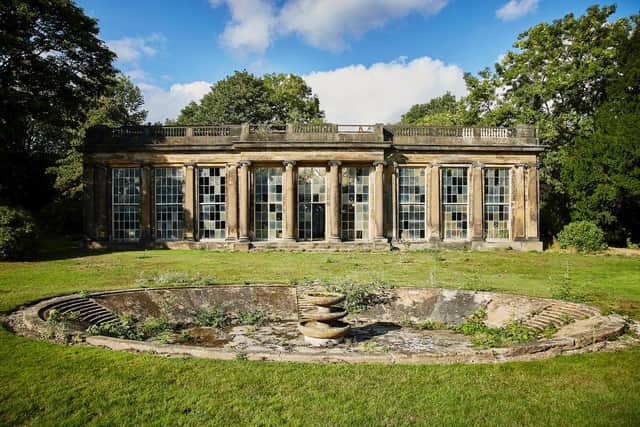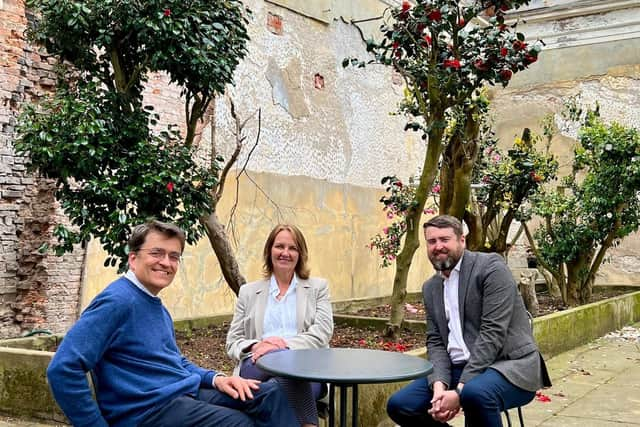Wentworth Woodhouse's 18th-century Camellia House to be restored as a tea house home to some of world's oldest specimens
Gardeners were astonished in 2019 when they found some of the oldest surviving specimens of camellia in the western world still thriving inside the semi-derelict structure with a collapsed roof.
They had been imported from China when the Marquesses of Rockingham owned the estate near Rotherham, as was the fashion in the Georgian era, and planted in a small building in the grounds which was also used as a menagerie and ladies' tearoom.
Advertisement
Hide AdAdvertisement
Hide AdNobody expected the 200-year-old plants to still be alive after decades of neglect and their discovery was hailed as the horticultural equivalent of finding a first edition of Wuthering Heights.


Now the Grade II-listed Camellia House, which was on Historic England's Heritage At Risk register, is to be brought back to life thanks to a £4million grant from the National Lottery Heritage Fund.
The Wentworth Woodhouse Preservation Trust, which bought the ancestral seat of the Earls Fitzwilliam in 2017, had previously confirmed that the building would become a hospitality venue with the camellias as the focal point, but they have now released more detailed plans.
The Camellia House is to be transformed into a teahouse celebrating tea culture from around the globe - as well as honouring its origins as a place where Lady Rockingham and her friends would retire for company and refreshment. Both tea and camellias represent the results of an age of global exploration by the British, whose exotic discoveries found their way into the homes and gardens of the country's aristocratic families.


Advertisement
Hide AdAdvertisement
Hide AdNow that vital repairs to the main house have been completed, the Trust's focus has moved to other projects around the grounds. Work will begin this summer and 22 jobs are to be created when the teahouse opens in summer 2023.
The Camellia House will also be an evening entertainment space and hold tea-themed events. Once a week it will host a community cafe for local groups, and art workshops and exhibitions are also planned.
The Trust's CEO Sarah McLeod said: "We are very grateful to National Lottery players via the National Lottery Heritage Fund for this significant grant award. We can now take a huge step forward in delivering our aspirations - regenerating Wentworth Woodhouse so it can benefit all people living in South Yorkshire and be an even greater source of local pride.
“Renovating the Camellia House is the first phase in our wider masterplan project to begin Wentworth Woodhouse’s new life, turning ‘Yorkshire’s hidden gem’ into a jewel in the crown of not only Yorkshire’s heritage, but the UK’s.
Advertisement
Hide AdAdvertisement
Hide Ad“The Camellia House’s global tea theme was chosen because of the building’s past, but also because tea is universal. The world’s most popular drink will help us to connect with a diverse range of audiences by placing different tea cultures in the spotlight.”
The Camellia House in its present form was built in 1812 and designed by Charles Watson, but the oldest part dates from the creation of a pavilion and an abutting greenhouse in 1738.
The pavilion was built, it is believed, as a place for guests to view the 1st Marquess’s menagerie of exotic animals, a collecting trend among the aristocracy in the mid-18th century.
Surviving original features include panelling and cast iron roof trusses.
Advertisement
Hide AdAdvertisement
Hide AdThe Camellia House had been inaccessible for a long period due to safety concerns before gardeners found the camellias while clearing brambles. One of the varieties present is Alba Plena, which was first brought to Europe in the 1790s, making the collection among the first generation of specimens imported from Asia.
Comment Guidelines
National World encourages reader discussion on our stories. User feedback, insights and back-and-forth exchanges add a rich layer of context to reporting. Please review our Community Guidelines before commenting.

